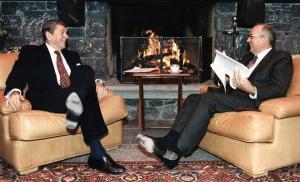Conceived in Geneva
On a cold November morning in Geneva, 30 years ago, two men met for the first time. Ronald Reagan and Mikhail Gorbachev, at the head of the world's two superpowers, had much to talk about.

At that moment in history, tension between the Soviet Union and the United States was high and there was a real risk that the Cold War would escalate—something that both men, despite their differences, were determined to avoid.
For the two days of the Geneva Summit (19-20 November 1985), the heads of state discussed reductions in nuclear stockpiles, the threat of a Third World War, and their common desire for lasting peace. "Anuclear war cannot be won and must never be fought," declared the joint statement at the end of the Summit.
The statement also advocated the "widest practicable development of international cooperation" in nuclear fusion in order to obtain a "source of energy, which is essentially inexhaustible, for the benefit of all mankind."
For years, influential members of the fusion community on both sides of great East-West divide had been calling for such a political initiative. "We knew that only a large international collaboration would permit us to build the 'Big Machine' that would demonstrate the scientific and technical feasibility of fusion energy," remembers Evgeny Velikhov, scientific advisor to Gorbachev and future president of the ITER Council (from 2010 to 2012).
The project was ambitious ... and likely to be expensive. In Geneva, the world's most powerful men had just given the needed political impetus.
An "international collaboration" had been set into motion. Two years later the initiative would have a name: ITER, for International Thermonuclear Experimental Reactor or, even more simply, "The Way" in Latin.
